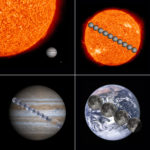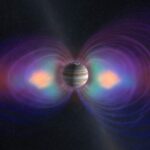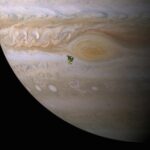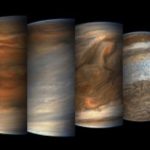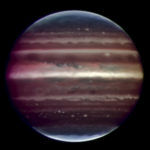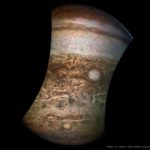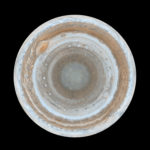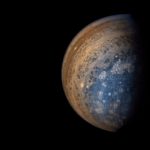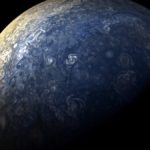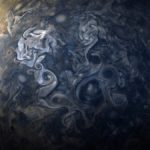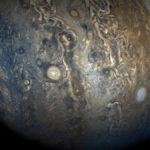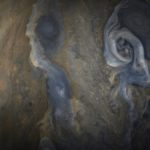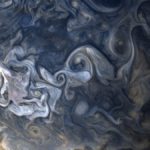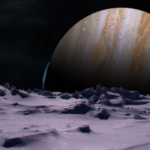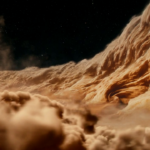This is the 2nd gas-giant formed in the Sun system.
–
Table of Contents:
- Planet Info; Spec’s
- History
- Moons
- Recent Major Cosmic Events
- Concepts (Images)
- Distant Orbit
- Close Orbit
- Moon Views
- In Atmosphere
- Final Notes
–
Planet Info:
Jupiter is the 5th publicly-known planet orbiting the star called the Sun. It is the largest planet in the Sun solar system, and, as such, functions as the system’s comet- and asteroid-absorbing shield. Entire meteor showers have been pulled into its gravity well, their gigantic nuclear-like explosions easily contained within its almost abyssal atmosphere, protecting all the other planets from catastrophic or terminal fates.
| Orbital characteristics[1] | |||||||||||||||
|---|---|---|---|---|---|---|---|---|---|---|---|---|---|---|---|
| Epoch J2000 | |||||||||||||||
| Aphelion | 816.62 million km (5.4588 AU) | ||||||||||||||
| Perihelion | 740.52 million km (4.9501 AU) | ||||||||||||||
| 778.57 million km (5.2044 AU) | |||||||||||||||
| Eccentricity | 0.0489 | ||||||||||||||
|
|||||||||||||||
| 398.88 d | |||||||||||||||
|
Average orbital speed
|
13.07 km/s (8.12 mi/s) | ||||||||||||||
| 20.020°[2] | |||||||||||||||
| Inclination | |||||||||||||||
| 100.464° | |||||||||||||||
| 273.867°[2] | |||||||||||||||
| Known satellites | 79 (as of 2018)[5] | ||||||||||||||
| Physical characteristics[1][6][7] | |||||||||||||||
|
Mean radius
|
69,911 km (43,441 mi)[b] | ||||||||||||||
|
Equatorial radius
|
|
||||||||||||||
|
Polar radius
|
|
||||||||||||||
| Flattening | 0.06487 | ||||||||||||||
| Volume |
|
||||||||||||||
| Mass |
|
||||||||||||||
|
Mean density
|
1,326 kg/m3 (2,235 lb/cu yd)[c] | ||||||||||||||
| 24.79 m/s2 (81.3 ft/s2)[b] 2.528 g |
|||||||||||||||
| 0.254 I/MR2 (estimate) | |||||||||||||||
| 59.5 km/s (37.0 mi/s)[b] | |||||||||||||||
|
Sidereal rotation period
|
9.925 hours[10] (9 h 55 m 30 s) | ||||||||||||||
|
Equatorial rotation velocity
|
12.6 km/s (7.8 mi/s; 45,000 km/h) | ||||||||||||||
| 3.13° (to orbit) | |||||||||||||||
|
North pole right ascension
|
268.057°; 17h 52m 14s | ||||||||||||||
|
North pole declination
|
64.495° | ||||||||||||||
| Albedo | 0.503 (Bond)[11] 0.538 (geometric)[12] |
||||||||||||||
|
|||||||||||||||
| −2.94[13] to −1.66[13] | |||||||||||||||
| 29.8″ to 50.1″ | |||||||||||||||
| Atmosphere[1] | |||||||||||||||
|
Surface pressure
|
20–200 kPa[15]; 70 kPa[16] | ||||||||||||||
| 27 km (17 mi) | |||||||||||||||
| Composition by volume | by volume:
Ices:
|
||||||||||||||
Further details here.
–
History:
Jupiter formed ~4,503,000,000 Earth-years ago. Originally much smaller, its core and atmosphere grew as it attracted most of the gas and other cosmic matter in the middle of the forming Sun solar system.
Many intelligent and advanced civilizations have used this planet over the millennia, at least one of which even built a moon inside its incredibly-deep cloud-cover.
Currently, most of its moons and atmospheric levels are occupied and patrolled by the colonies and Dark Fleet of the 3rd Reich. There are also colonies on some of its moons belonging to nations and lesser organizations working under the guidance of those Space-faring Germans.
The current ruler of this world and all its moons is Queen Jupiter Jones, one of High King Auzdein von Himmler‘s many flawless loving wives.
–
Jupiter’s Moons:
This gas giant has 69 known ‘satellites’ in stable orbits, though more are speculated. Some may still be undiscovered for various reasons. Some may even be cloaked in some way.
The top 4, by size, are:
- Ganymede: larger than both Mercury and Pluto, it is 2/3 the size of Mars with a diameter of 5,268 km (3,273 miles) – 8% larger than Mercury. It has the highest mass of all planetary satellites and has more than twice the mass of the Earth‘s Moon.
- Callisto: At 3,000 miles (4,800 km) in diameter, Callisto is roughly the same size as Mercury. It is the third largest moon in the solar system, after Ganymede and Titan. (Earth’s moon is fifth largest, following Io.)
- Io: 3642.6 km, or 0.28 Earths, wide. It only has a mass of about 1.4% of the mass of Earth. It is very comparable in shape (form) and diameter to Earth’s moon.
- Europa: tidally locked; so the same side faces Jupiter at all times. Size: Europa is 1,900 miles (3,100 km) in diameter, making it smaller than Earth’s moon, but larger than Pluto.
–
Recent Major Cosmic Events:
Between 2 and 4 July of 1994, the ‘Shoemaker-Levy 9’ comet had passed the Roche limit of Jupiter, and from 16 to 22 July of that year, its fragments began falling into the Jovian atmosphere at speeds above 130,000 MPH. The series of impacts left blast marks the size of smaller planets, and persisted visibly for months, more prominent than even the Great Red Spot storm (or ‘eye’) of the gas giant. These were actually a new form of bomb made to probe and warn the beings posing as deities on Jupiter; Shoemaker-Levy 9 had been pushed in for this very purpose.
On 19 July 2009, another large body entered Jupiter’s gravitational pull and impacted the planet, causing a black blast mark the size of the Pacific Ocean. It is debated what this object was; comet, asteroid, or something else, as only the explosion and aftermath were observed. Most likely, it was another weapons test overseen by Dark Fleet.
Details here.
–
Concepts:
–
Distant Orbit:
–
Close Orbit:
–
Moon Views:
–
In Atmosphere:
–
Final Notes:
Don’t let this gas-giant’s dominant present size fool you; Jupiter (once called Zeus) formed long after Earth, Uranus, Saturn, and even Mars and Venus were formed. Uranus and then Saturn came out of the Earth’s once much-deeper gas-giant-like atmosphere, as (later) did the (one) Cyclops and (one) Hekatonkheir that became Venus and Mars. By the time the bulk of Earth’s atmosphere (Firmament) separated to form Jupiter, most of the original solar system was already in a stable alignment (none of the worlds rotating to have days and nights, or orbiting anything back then). Jupiter’s growing presence pushed Saturn back away from the Earth while diminishing and blocking its dim Sun-like glow. Much of Saturn’s atmosphere (Firmament) was also added to Jupiter’s, though not nearly as much as Jupiter took from the Earth.
It is not yet known if Asteron was formed inside Jupiter, like Earth’s latest moon (The Moon) is said to’ve been, and/or if Asteron was shattered into the Inner Asteroid Belt by the growth and new movement/s of Jupiter, among other things.
Jupiter continues to absorb comets and other cosmic bodies, sometimes adding them to its mass, and other times using them to help form still more moons. Dozens of moons orbit it now, many (and perhaps all) of which formed in its atmosphere (Firmament). Who knows when its reign and production (of moons) will end, it being replaced by yet another giant world as the new dominant and central one, perhaps shrinking it like its formation once shrank the Earth, and perhaps turning even it into… just another Earth or moon.
…
2023 December: Saturn didn’t eat his own children; ancients on Earth witnessed in their sky, when Saturn was much closer, moons being practice-formed from Saturn and then reabsorbed into its atmosphere, and modern humans intentionally idiotically mistranslated and mis-taught the tale/account of that.
..
Jupiter didn’t castrate Saturn; that was another intentional idiotic mistranslation by the always-evil/wrong humans. Saturn, after practice-making many moons, formed a world even bigger than it, knowing that would help shield it from cosmic debris from its experiments (by gravitationally attracting otherwise-threatening asteroids, comets, etc.), thus Saturn was no longer the biggest/dominant world / Sphere Being in the Sun system, and that was poorly expressed by primitive insecure weirdo humans as having lost its manhood/balls. It lost balls only in the sense that some of the spherical moons it made migrated away to Jupiter, or including Jupiter.
Venus was one of those moons/subordinates, thus the poorly-translated story/claim/myth that from the foam of Saturn’s castrated parts… came/arose this beautiful/glowy world.
…
2024 February: Why the Moon takes 28 days to orbit the Earth, but Io takes only 1.77 to orbit Jupiter: “The distance of Io to Jupiter’s barycenter is about 425K km, compared to the Moon’s distance to the Earth of ca 400K km. Very comparable. However, Jupiter is 318 times more massive. This means that it is in effect a much LOWER orbit than the moon’s, and therefore the orbital period must be smaller.”
Io’s orbit is ~1,780,000 miles long (circumference).
..
From the surface of Io, Jupiter would subtend an arc of 19.5°, making Jupiter appear 39 times the apparent diameter of Earth’s Moon.
..
From Jupiter, the Sun appears to cover only 5 arcminutes, less than a quarter of its size as seen from Earth.
–
Also see:
–
